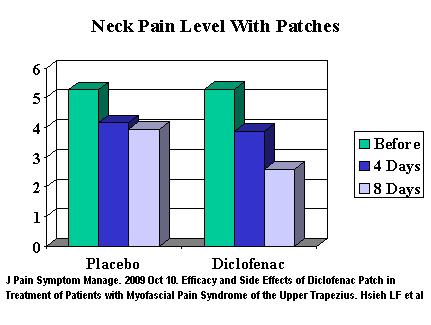A weeks worth of patch wear was associated with a significant relief of neck pain though the deeper trigger knots were still sore
J Pain Symptom Manage. 2009 Oct 10. [Epub ahead of print] Efficacy and Side Effects of Diclofenac Patch in Treatment of Patients with Myofascial Pain Syndrome of the Upper Trapezius. Hsieh LF, Hong CZ, Chern SH, Chen CC. abstract here
- patches are 10 X 14 cm and contain 60 mg Diclofenac .060 gm/ 10 x 14 x.1 cm = about 0.4% gel though in another article they mention 1% having a good penetration. One speaker I listened to, felt 6-7% was necessary for a good cream. They used an epolamine salt – ? more penetration – at ph 7 is 12 times more soluble than the sodium salt.
- “Patches were applied on the skin surface of the affected region in a direction parallel to the muscle fibers of upper trapezius three times a day for seven days.”
- Results:

Sounds good if could be made homemade with gelatin…
anyone got recipies (not cream/gel based)?
OK here comes one:
You can make a nice gel layer with knox gelatin:
1 TBSP = one pack in 2/3 cup water – slightly mushy gel
2 TBSP = two packets in 2/3 cup water – good gel
heat up when want to use
consider adding a bit of baking soda to make alkaline (explained later)
50 mg Diclofenac tablet in crushed and dissolved in heated 10 mls of gelatin ph 8 would be nice…
reason is, diclofenac is not very soluble but is eight times more soluble at ph 8 than 7…
Pour contents onto tinfoil flattened into a 6 inch lid – let harden.
Tape down gelatin side of tinfoil to affected area – the harder one might resist melting better but the mushy one might be more bioavailable.
A no-no – would be nice to add lidocaine hydrochloride but has a PH of 2-3 and diclofenac would be insoluble. Could use lidocaine base but that stuff is insoluble…
All sorts of alternative measures:
propylene gycol increases solubility greatly but probably makes it very mushy
Present mix makes it 0.5% – its solubility at PH 7.4 – body ph; but the sky is the limit…
Anyone tried this?
